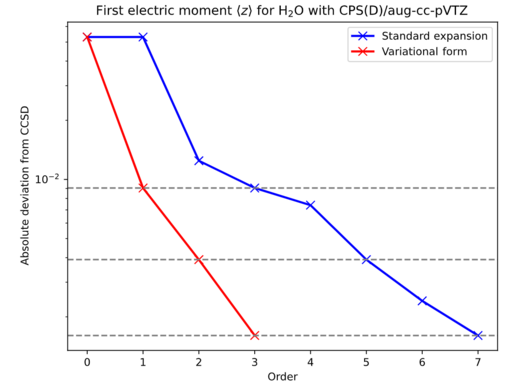Article published in Science Advance
"A variational reformulation of molecular properties in electronic-structure theory"

Cluster Perturbation Theory: Achieving accuracy and computation efficiency at the same time
The continuing cost increase of performing experimental research in chemistry and related fields, and the continuing cost decrease of performing computational simulations, clearly emphasizes that computational modelling will have an ever increasing role in future research. While Moore’s law is often invoked to rationalize the rapid increase in computational capacity, an overlooked fact is that for high accuracy computational modelling, advances in the theoretical methods have led to significantly larger improvements than given by Moore’s law.
In a recent breakthrough lead by Prof. emeriti Poul Jørgensen and Prof. Jeppe Olsen from the Department of Chemistry published in Science Advances, the currently most accurate, but computationally demanding, coupled cluster method has been reformulated into a perturbative form that is computationally much less demanding while preserving the accuracy. An important component in the reformulation is that it readily allows utilizing millions of computational cores and is thus optimum for modern computers.
A key point in the reformulation is a recasting of the energy expression into a Lagrange form that is variational in all parameters, as this allows calculating all properties with an accuracy that is quadratic in the wave function error, while current methods have linear errors. With the new formulation, a wave function accurate to 0.1 thus allows properties to be calculated with errors of 0.01, and a wave function accurate to 0.01 allows calculating properties with errors less than 0.0001, compared to errors with current methods of 0.01.
A second important point in the Science Advances paper which builds on nine previous publications over the latest five years, is to replace an iterative solution of large dimension non-linear equations with a second order perturbative approximation that can readily be implemented on millions of computational cores to vastly reduce the computational time. The second order approximation is a sweet-spot in efficiency, as it introduces negligible errors in the final results while remaining computationally efficient.
The perspective of the new reformulation is that it readily allows extensions to arbitrary higher accuracy and can be applied for any molecular property, thus enabling computationally efficient modelling of almost any conceivable molecules and associated properties. Being based on only fundamental physics, the methodology provides a computational tool that is free of user biased parameterizations and is applicable to essentially any molecular system.
Link to scientific article:
A variational reformulation of molecular properties in electronic-structure theory
by Poul Jørgensen, Jeppe Olsen, Magnus Bukhave Johansen, Theo Juncker von Buchwald, Andreas Erbs Hillers-Bendtsen, Kurt V. Mikkelsen, Trygve Helgaker
The article can be read via this link:
https://www.science.org/doi/10.1126/sciadv.adn3454
Additional information | |
We strive to ensure that all our articles live up to the Danish universities' principles for good research communication (scroll down to find the English version on the web-site). Because of this the article will be supplemented with the following information: | |
External collaborators | Copenhagen University and University of Oslo |
External funding | Independent Research Fund Denmark |
| Conflict(s) of interest | None |
Link to scientific article | |
Contact | Poul Jørgensen |
